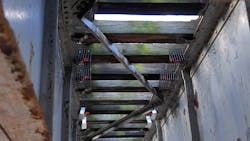MTA announces comprehensive new measures to prevent falling debris, completion of systemwide inspection blitz of containment baskets
The New York City Transit (NYCT) is undertaking a new series of measures to prevent and address challenges associated with falling debris in the subway system, according to an announcement from NYCT.
The announcement comes in the same week that inspectors completed a systemwide inspection of approximately 325,000 containment baskets throughout the system. NYCT officials also announced that Terri Rumph, an NYCT executive, has been tasked with leading the organization’s Division of Track. In this role, she will be responsible for maintenance and construction activity across all 800 miles of NYCT tracks, including ongoing efforts to improve the track inspection process.
“We began the week immersed in a massive, systemwide inspections blitz, carefully examining hundreds of thousands of containment baskets on track all throughout the system,” said NYCT President Andy Byford. “We end the week having launched tangible new protocols that will continue to ensure we are doing everything we can to keep our millions of customers safe. Make no mistake: we will not rest until we’ve exhausted every possible innovative solution we can to address this challenge. Safety is always our foremost concern and we will never relent when it comes to that mission.”
The news came during an event held at the Tiffany Street Iron Shop in the Bronx where transit officials demonstrated some of the new techniques and hardware components NYCT has begun to deploy as part of ongoing efforts to combat the problem of falling debris, including a new prototype retainer basket. Work to address this challenge began last winter and the deployment of protective netting was already underway prior to the unprecedented inspection blitz of the last week. NYCT leadership continues to examine new and innovative ways to keep elevated tracks safe.
“Today marks the end of a comprehensive series of inspections, but our work to reduce falling debris continues in earnest,” said Sally Librera, senior vice president for subways, NYCT. "We’re also deploying existing technologies like video from our track geometry car in new ways so that we can identify potentially vulnerable parts of the system. And we have appointed a very talented and experienced chief of track. Terri Rumph is an expert leader and I have full confidence she will leverage her decades of experience in infrastructure and track to identify innovative approaches for keeping elevated tracks safe."
Moving forward, NYCT will apply an even greater level of rigor to its inspection process by requiring that any condition on the elevated structure that could lead to falling material be given highest priority for resolution. This change has been codified in the official maintenance standards that inspectors and other subway employees use when inspecting and maintaining track. NYCT will also continue to look for engineering solutions that keep hardware in place, as well as ensure secondary protective measures are comprehensive and effective. Track supervisors are already leveraging Enterprise Asset Management tools for doing this work, logging findings directly into handheld devices and cutting down on paperwork in the process.
“I recognize the urgency of this work and of the need to improve the way we tackle these challenges moving forward. It’s an incredible honor to be tapped for this role and I am eager to get started,” Rumph said. “We’re changing the way we prioritize which defects get immediate repairs so that we can address issues on the elevated structure as fast as possible. We have an outstanding team of dedicated track inspectors in place who adhere by a rigorous set of standards when checking vast sections of track each day for potential defects. Even so, there is always more we can be doing and I am prepared to lead when it comes to identifying how we can improve our work further.”
